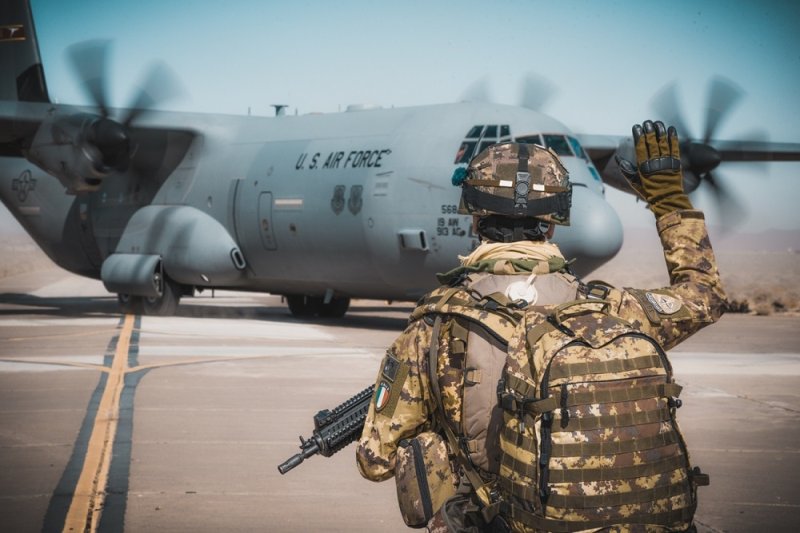The Example and Sacrifice of the 'Perugia' Division in Albania at the Historical Epilogue of Autumn 1943
While remembering the enormous sacrifice of the fallen Italian soldiers, of the shattered young lives of the so-called boys of ’99, we cannot but think of them with deference and gratitude. Perennial is the gratitude of the Nation to them that arises from the devastating experience in the trenches that ended with the victory of November 4, 1918, finally marking the end of the long and bloody conflict of World War I for Italy.
November 4, 1918, shaped profoundly the future of the European nations and left an indelible mark in the course of the history throughout the 20th century.
A total of 8,000 of those young soldiers died here, in Albania. If we considered only for a moment World War II, the total number of the Italian soldiers fallen in this country would amount to around 28,000 - a figure resulting also from the tragic historical epilogue of the autumn of 1943, in the aftermath of the Anglo-American truce.
It is particularly worth mentioning that in September 1943, Albania was guarded by the 9th Army of what back then was known as the Italian Royal Army, divided into two Army Corps and six Divisions (Perugia, Parma, Brennero, Florence, Arezzo, Puglie). The September 8 armistice sparked a crisis of command and control so significant that the Supreme Command began issuing confusing orders on how Italian troops would handle the situation, especially with the Germans.
Following tense fights, on September 11, Germans entered Tirana arresting the Commander of the 9th Army, Gen. ROSI, forcing him to order the capitulation of his soldiers in exchange for the supposedly untrue promise to repatriate the Divisions under his command. The order met with the refusal of some heads of divisions, as it went against military honour, and set in motion the disbandment of the Italian military units. Each Division commander responded considering the local situation: some of them tried to reach the shores and eventually embark to Italy, while others took to the mountains in the hinterland to escape and join the Albanian liberation movement. At the time of the truce, the “Perugia” Division operated in Gjirokastër, Delvinë, Jorgucat, Tepelenë, Këlcyrë and Përmet.
With all connections cut off with the superior command, the “Perugia” had to handle the crisis alone, after the September 8 truce. Reaching Saranda on September 21, they rallied to defend the port, giving protection to thousands of soldiers from the disbanded “Parma” Division.
On September 26, the Germans tried to land in Saranda, but they were pushed back, and the “Perugia” also captured 15 prisoners among them. The coming days were filled with uncertainty. When news finally broke that the Italian ships would reach Porto Palermo, in view of the impending German threat, the commander ordered the troops to head north. On their way to Porto Palermo, convinced they would embark on the ships, the order to surrender the weapons to the Albanian partisans was issued. On September 28, Perugia’s infantrymen arrived in Porto Palermo, but did not find the ships the Allies had sent from the ports of a liberated Italy.
In the meantime, the Germans had set in motion a true manhunt from South up to the North. Now unarmed, the units of the Perugia were divided into groups and with the help of the Albanians sought shelter in the mainland hills. Alas, they could not escape Germans combing every inch, and, eventually, almost all the Italians were captured and held prisoners.
At the hands of Germans, their fate was the same with the Italian soldiers at the Greek islands (we cannot but remember here the sacrifice of the entire Acqui Division in Cephalonia, with more than 9 000 men slaughtered), death for all Officers and transportation to concentration camps for all the others.
The Italian soldiers of Perugia Division were accused of having warded off the German attempt to disembark in Saranda, of facilitating the embarkment of several groups to Puglia – back then, under the Anglo-American occupation – and of colluding with the Albanian partisans.
The tragic epilogue occurred between October 4 and 7, in two different locations. On October 4, in Limion Bay, Gen. CHIMINELLO, Commander of the Division and his military chief were killed. The next day, Colonel Giuseppe Adami, vice-commander of the Division, would write in his diary on that same place “officers, separately from the troops, were taken on boats in groups of eight offshore and were thrown into the sea - it is unknown whether they were shot before,” while “the soldiers witness helpless from the shore the harrowing slaughter”. Several reports indicate that 120 officers suffered this end, others take it to 150. Additionally, on October 7, 32 officers were captured and executed in Kuç, a location not far from Saranda.
From that event we remember men of extraordinary heroism, who were awarded the Golden Medal of Military Valour, among whom, Col. Gustavo LANZA, Commander of the 129° Regiment that refused to lay down the weapons who, captured after a devastating fight, attempted, taking full responsibility, to save his men from retaliation. Another one is Lieutenant Colonel Emilio CIRINO who, after leading the return to Puglia of several units, insisted on going back to Albania, in order to stand by his Unit. The other victims of this massacre were honoured with the Silver Medal of Military Valour.
Around 170 surviving soldiers from the Perugia Division joined the ranks of “Gramsci” and “Matteotti” Battalions, formed by the remaining soldiers of other units present in Albania, who would go on to participate in numerous operations against the Germans. They contributed to the takeover of the Capital, parading in Tirana as liberators on November 28, 1944.
Fabrizio Bucci, Ambassador of Italy, Tirana













